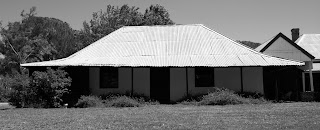Serpentine Heritage and Culture Trail 2012
or
Living Histories Stage 2
The project has commenced and is progressing well. The variation in name came about over time during the process of seeking and making funding application and reappplication to the various funding bodies that support this project. I'm not sure how it happened, however the intent of the project always remained the same.
(a short history of Serpentine)
In
1840 Thomas Peel became the first
European settler in the district when
he established Serpentine Farm
on the banks of the Serpentine
River; in the middle of his
250,000 acre land grant. Today the
farm is known as ‘Lowlands’.
Thomas Peel cottage today
Lowlands is auguabley the earliest and finest example of a continual working farm in WA, and thanks to the vision of Midge Richardson, a considerable portion of the remaining farm has been returned to natural bush, flora and fauna. Many environmental science students have visited the farm for field study and today it continues to develop as a sanctury for some endangered species long since gone from the remainder of the Peel Coastal Plain.
The Old Shearing Barn
an example of early fencing
another iconic buildings that can be found at Lowlands
Not long afterwards, farmland was also taken up at Wungong and Cardup.‘Woongan’ soon became known as one of the choicest farms on the whole colony. Whitby Falls Estate also flourished, and families soon began to settle in the foothills and along the banks of the Serpentine River.
In 1872 the timber industry began to develop at Jarrahdale, with timber being taken by rail to Rockingham to export. Countries all over the Commonwealth used Jarrahdale jarrah for furniture, building, decoration and road paving. This timber industry was important to the development of the young state of Western Australia as it employed over 2000 people in its heyday. The last mill closed in the early 1990s. A group settlement scheme in the 1920s brought migrants from Britain to establish farms on the sandy soils of the coastal plain which was often inundated for up to seven months of the year. The equestrian industry developed a foothold very early in the Shire’s history and has grown rapidly since the 1960s. The Shire began to experience exceptional growth when reticulated sewerage (2001) brought medium density urban development to the Byford area from 2006.
Today, Serpentine Jarrahdale is a thriving agricultural and rural lifestyle district that continues to make the most of its unique geographical and cultural attributes. (info taken from the Shire of Serpentine Jarrahdale website).
Those interested in what led to the present project can find further info at an earlier posting.
Those interested in what led to the present project can find further info at an earlier posting.





No comments:
Post a Comment